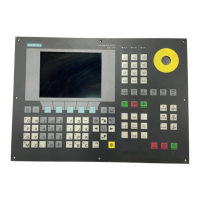Detailed Description
2.1 Spindle modes
Spindles (S1)
2-10 Function Manual, 08/2005 Edition, 6FC5397-0BP10-0BA0
SPOS, M19 and SPOSA have the same functionality, but differ in their block change behavior:
• Programming with SPOS and M19
The block change is carried out if all functions programmed in the block have reached
their endofblock criterion (e.g., all auxiliary functions acknowledged by the PLC, all axes
have reached their end points) and the spindle has completed its positioning motion.
• Programming with SPOSA
The program moves to the next block if all the functions (except for spindle) programmed
in the current block have reached their end-of-block criterion. If SPOSA is the only entry in
the block, block change is performed immediately. The spindle positioning operation may
be programmed over several blocks (see WAITS).
Coordination
A coordination of the sequence of motions can be achieved with:
• PLC:
If NC/PLC IS:
DB31..., DBX 83.5 (spindle in setpoint range)
is not active, channel-specific signal:
DB2x, DBX 6.1 (read-in disable)
can be set in order to wait for a particular spindle position.
• MD configuration:
Setting:
MD35500 $MA_SPIND_ON_SPEED_AT_IPO_START = 1
is used to perform path interpolation taking the tolerance:
MD35150 $MA_SPIND_DES_VELO_TOL
into account only if the spindle has rotated up to the preselected speed.
Setting:
MD35500 $MA_SPIND_ON_SPEED_AT_IPO_START = 2
stops traveling path axes before the start of machining at the last G0.
Machining continues:
– On the next traversing command
– If the spindle speed is reached
– When MD35510 $MA_SPIND_STOPPED_AT_IPO_START = 1
(path feed enable, if spindle stationary)
• In the part program:
Coordination actions in the part program have the following advantages:
– The part programmer can decide at what point in the program the spindle needs to be
up to speed, e.g., in order to start machining a workpiece.
– This avoids unnecessary delays.

